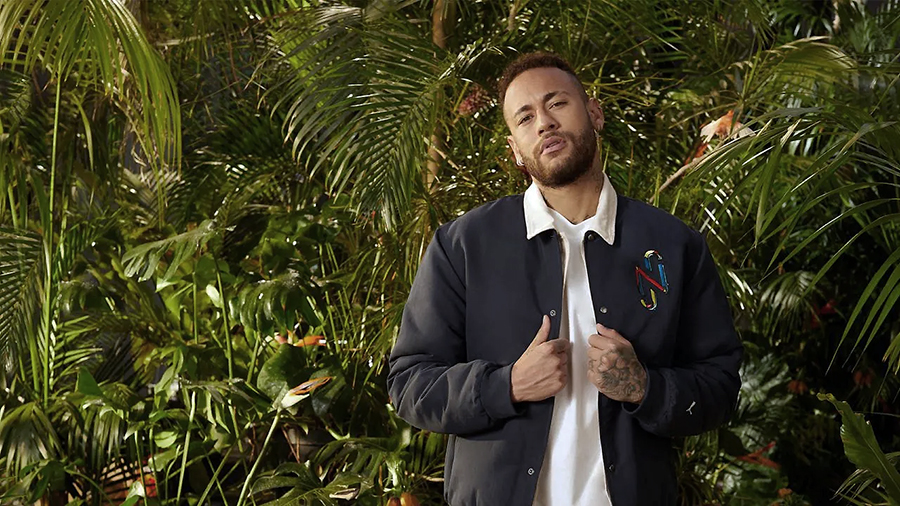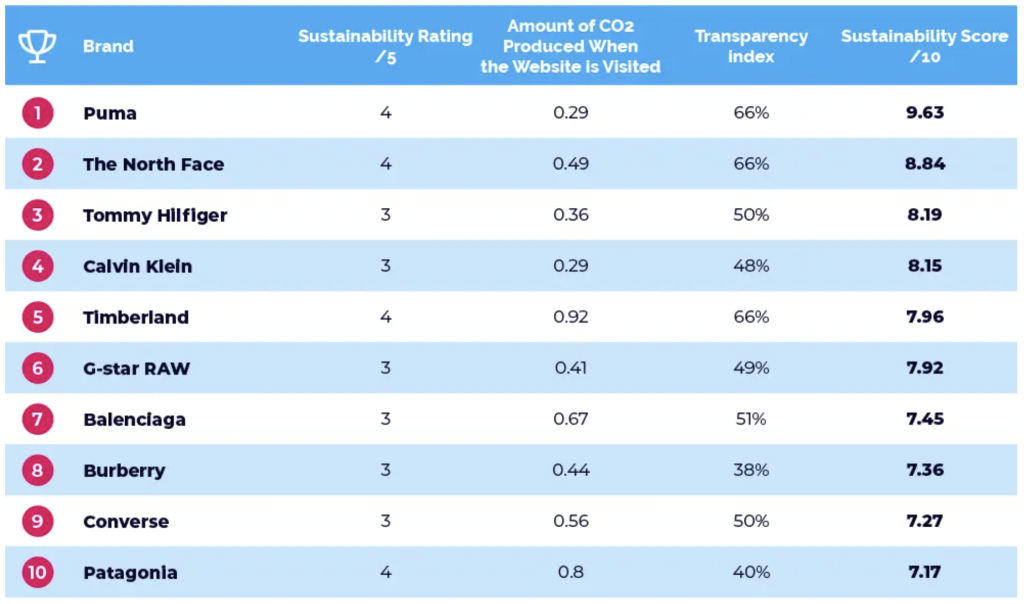SGB Media often fields releases claiming a brand’s sustainability bonafides as the fashion world, one of the largest contributors of CO2 emissions and water pollution, with marketing messages focused on using eco-friendly materials and components and the recyclability of its products for resale/reuse.
Cutting through the clutter of the claims and counter-claims made to address the concerns of consumers, especially younger consumers who are far more aware of the world they live in, the UK-based Utility Bidder took a unique view of the sustainability conversation and used energy as the factor in determining a brand’s sustainability rating.
Utility switching service Utility Bidder’s Fashion Energy Report examined sustainability ratings and transparency on where/how products are manufactured and the amount of CO2 emissions produced when a brand’s website is visited.
“While some businesses have outlined initiatives to reduce their carbon footprint, many companies, and in some cases entire industries, still need to catch up,” Utility Bidder said in its report.
The report notes that the fashion industry uses more than 90 billion cubic meters of water annually, a prime example of an issue not often discussed by brands—enough to meet the needs of five million people and is projected to double by 2030.
As of 2022, the fashion industry reportedly accounted for 10 percent of the world’s CO2 emissions, more than international flights and shipping.
With these factors in mind, many companies have outlined plans to be more environmentally friendly, but the question arises of which fashion brands are succeeding and which brands are trailing in their efforts. SGB compiled highlights from Utility Bidder’s Fashion Energy Report below that address the question. To read the full report, go here.
Overall Sustainability Score
1. Puma – 9.63
The most sustainable fashion brand is Puma, with an almost perfect score of 9.63 out of 10. The German company predominantly manufactures athletic apparel, accessories and footwear. Not only is Puma a leading manufacturer in the world of sport, but it is also a leader in sustainability with a high sustainability rating, a high level of transparency and a low amount of CO2 produced whenever someone visits their website.
2. The North Face – 8.84
In second place is The North Face, with a sustainability score of 8.84 out of 10. The North Face designs clothes and equipment for outdoor recreation, including skiing, hiking, and camping. Sustainability has been a massive focus for the American company, and, by 2025, it aims to manufacture all clothing using 100 percent responsibly sourced materials.
3. Tommy Hilfiger – 8.19
Completing the top three is Tommy Hilfiger, with a sustainability score of 8.19 out of 10. Tommy Hilfiger is one of the most recognized brands worldwide, recording more than $9 billion in sales in 2022. Part of Tommy Hilfiger’s Climate Action Plan involves all stores and distribution centers be 100 percent powered by renewable energy by 2030.
To determine which brands put in the most effort, the Fashion Energy Report looked at sustainability ratings, transparency and the amount of CO2 produced when a company’s website is visited. Below is a summary of some of the key metrics:
Sustainability Rating
To determine a brand’s commitment to other factors that determine a company’s goal for a better future, the Fashion Energy Report turned to Good On You, a rating service for brands and consumers to assess how a brand treats its workers, its environmental policies, and its effect on animals.
To give each fashion brand a sustainability rating out of a possible score of 5, Good On You used these three factors and its resulting rating system to review some of the world’s largest fashion brands to determine which has the highest sustainability rating.
Puma was again at the top of the Sustainability Rating, followed by The North Face, Timberland and Patagonia.
- Puma – 4/5 Sustainability Rating
Puma takes the top spot again, with a sustainability rating of 4/5. Puma’s emphasis on recycling is pivotal to its high rating, as the German brand uses recycled materials with other lower-impact fabrics. Puma also offers a clothing recycling program—Bring Me Back—to combat end-of-life textile waste. Customers can bring used shoes, clothes,and accessories to Puma stores, which will be reused or recycled for new products. - The North Face – 4/5 Sustainability Rating
The North Face has a formal animal welfare policy, which helps it to rank high on the list. It’s down is certified by the Responsible Down Standard and does not use fur, exotic animal skin, exotic animal hair, or angora. Other contributing factors include its science-based target to reduce greenhouse gas emissions and its policies to protect workers from the impact of COVID. - Timberland – 4/5 Sustainability Rating
The next fashion brand to share the top spot is Timberland, which also has a 4/5 sustainability rating. Similarly to The North Face, Timberland’s animal welfare policies help drive its overall sustainability rating. It has a formal policy aligned with the Five Freedoms of Animal Welfare and uses recycled wool, leather and down. - Patagonia – 4/5 sustainability rating
Patagonia uses low-impact materials, which limit chemicals and wastewater, as well as recycled wool, down and exotic animal hair. Its worker treatment also helps Patagonia’s overall rating, with the Fair Labor Association (FLA) accrediting its final production stage. Workers in this production stage are also paid living wages, contributing to Patagonia’s 4/5 sustainability rating.
Website CO2 Use
All brand and retailer websites have a carbon footprint, which can be affected by the energy source used by the data center, the energy intensity of the web data and the data transfer over the internet. With online shopping so crucial for these companies, the report looked at the fashion brands with websites that produce the most CO2 per page visit.
The brands that used the least amount of CO2 per page visit include Nordstrom at #1, followed by Puma and Calvin Klein, and Tommy Hilfiger. Aldo, Hugo Boss and Abercrombie & Fitch were said to produce the most CO2 per page visit.
- Nordstrom – 0.03g of CO2 produced per page visit
Taking the top spot is Nordstrom, with just 0.03g of CO2 produced per page visit. The American company originally opened as a shoe store but has since branched out to clothing and accessories. Nordstrom’s website is so efficient that if visited 10,000 times a month, it would emit as much carbon as one tree would absorb in a year. - Puma/Calvin Klein – 0.29g of CO2 produced per page visit
Puma and Calvin Klein share second place, with 0.29g of CO2 produced per page visit. Both websites are cleaner than 68 percent of websites across the world. If their websites had 10,000 monthly page visits, it would produce enough energy to charge a smartphone 7,500 times. - Tommy Hilfiger – 0.36g of CO2 produced per page visit
Completing our top three is Tommy Hilfiger, with 0.36g of CO2 produced per page visit. This brand’s website is cleaner than 62 percent of websites globally. Over a year, with 10,000 monthly page visits, this website would produce the same amount of energy as two trees would absorb.
The report also had an interesting metric that reflected the number of trees a brand or company would have to plant to offset the CO2 produced by their websites.
Transparency
The report also suggests that a brand’s transparency with its customers is important so that they know where products come from and how they are made. Each year, Issuu looks at public disclosure of human rights and environmental policies, practices and impacts across some of the largest fashion companies’ operations and supply chains. The report delved into the 2023 Edition of Issuu’s Transparency Index to reveal the most transparent fashion brands.
Gucci is the most transparent, followed by H&M, Puma, The North Face, and Timberland.
- Gucci – 80 percent Transparency index
The most transparent fashion brand is Gucci, with a transparency index of 80 percent. Gucci is one of the biggest names in fashion, producing luxury clothes, accessories, shoes, and cosmetics. In the past, luxury fashion brands have earned a reputation for secrecy. However, Gucci has stepped away from this assumption. - H&M – 71 percent Transparency index
The second most transparent fashion brand is H&M, with a transparency index of 71 percent. H&M are one of the more affordable brands on our list. In 2022, 84 percent of its materials were recycled or sustainably sourced; by 2040, it aims to achieve net zero greenhouse gas emissions. - Puma/The North Face/Timberland – 66 percent Transparency Index
Puma, The North Face, and Timberland complete the report’s top three, all with a transparency index of 66 percent. Puma, The North Face, and Timberland were all high-ranking companies in the overall list, ranking first, second and fifth, respectively.
Tips for Improvement
Utility Bidder wrapped up its Fashion Energy Report with tips from experts to reduce a company’s carbon footprint, with a focus on practicing sustainable measures.
- Measure Carbon Footprint — Measuring your carbon footprint is crucial as it can help you understand your business’s impact on the environment. You can establish realistic targets and measure your yearly progress by measuring your carbon footprint. It can also help you see which areas of your business are more harmful than others, making it easier to understand how to tackle this. There are many tools available online to help measure your carbon footprint.
- Switch To Renewable Energy — Not only is it essential to get the best business energy rates possible, but it’s also important to consider where your energy comes from. The primary renewable energy source in the UK comes from wind turbines, which generate around 13 percent of Britain’s total electricity. Many businesses and homeowners have also installed solar panels to generate electricity.
- Switch To Sustainable Suppliers — Companies and their suppliers must be transparent with each other so that they are aware of how they practice their business. Ensure your suppliers are using recyclable materials and practicing sustainable measures.
- Upgrade Office Lighting and Heating Systems — Working from home has become the norm in the last couple of years; however, many people are returning to the office. Upgrading your lighting and switching to LED bulbs is a great place to start. Upgrading your heating system is another excellent way to improve your carbon footprint—switching to oil-filled heaters are up to 99 percent energy efficient.
Methodology
Utility Builder used various seeding lists, including YouGov and Fashion United, to create a seeding list of fashion brands. Good On You was used for the sustainability rating out of five; Carbon Calculator was used for the quantity of CO2 produced every time its website was visited; Semrush was used to find the number of monthly page visits for the Top 10 fashion brands producing the most CO2 per page visit; Carbon Calculator was used again to find the number of trees it would take to absorb the CO2 produced; Transparency Index percentages came from Issuu. The company put these factors into a weighted table, giving each factor a normalized score out of 10. It then took an average of the scores to get an overall score out of 10. All data is accurate as of April 12, 2023.
Image courtesy Puma

















